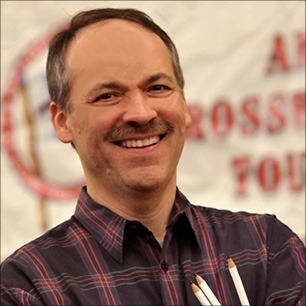The Golden Age of Crosswords
At the height of its popularity, the pleasurable pastime reaches a crossroads

When Will Shortz took over as its editor in 1993, The New York Times crossword puzzle was widely viewed as moribund (clue: lacking vitality). At the time, the crossword was the stodgy province of literary types where straightforward dictionary definitions passed as clues. But Shortz helped breathe new life into a stale American pastime, elevating it to the pleasurable ritual of wordplays, juicy themes, and tantalizing twists we know today.
“The evolution is slow, but there are lots of crossword submissions made to The Times today that I would have accepted ten or twenty years ago that I can’t accept now because the standard of puzzle making has increased,” says Shortz, who hosts a virtual talk about crosswords and table tennis on January 28 for UCSB Arts & Lectures. “We get more interesting, cleverer themes. The crosswords are more playful than ever.”
Shortz is the world’s most recognizable puzzle master and the only person known to hold a college degree in enigmatology (clue: the study of puzzles). He has arguably done more than anyone alive to spread the popularity of crosswords. Since he joined The New York Times, he has published hundreds of crossword books and many other crosswords have spawned in that time. The American Crossword Puzzle Tournament he founded in 1978 breaks records in attendance year after year. The 2020 tournament, which was cancelled due to the pandemic, would have been no exception.
Yes, it can be said we are living in the golden age of crosswords. The modern crossword craze is partly a product of technology. In 1993, virtually all puzzles were created by hand on draft paper. Today nearly all puzzle constructors use computer software equipped with digital troves of possible answers that can be finetuned and amended with words not available in the dictionary. “The entire world is at your disposal,” says Shortz. ”That’s one way that crosswords have gotten better and it’s gotten more competitive.”
The Internet has only widened the arena of available options. In 2018, The New Yorker, a magazine that had barely dabbled before in crosswording, launched an online weekly crossword. “Most of our readers have e-mail addresses now, and the Web has given us the space to try new things – and to try old things again,” the magazine’s editor David Remnick wrote at the time.
Crossword popularity has only surged since the start of the pandemic. When Shortz started at The Times, he said he received between 40 and 50 submissions per week from crossword constructors. Since March, he has gottenas many as 200 submissions per week and the newspaper can only publish seven. “Since the pandemic two things have changed,” Shortz explains. “One, people are at home and they have a lot more time on their hands. The other is that we started accepting submissions electronically. It used to be that you had to send them by mail, which was kind of a pain. That convenience factor has increased the number of submissions we get.”
Last month, The Times pushed the technological boundaries of crosswording even further, announcing the debut of a new augmented reality-enabled game, Shattered Crosswords, available on Instagram. The game allows players to solve clues by rotating broken crossword pieces in augmented reality.
Crossworders at Cross Purposes
The crossword puzzle is a distinctly American invention, like jazz or Eggs Benedict. The first was created in 1913 and the activity became vogue in the 1920s and immediately jumped to England and then around the world.
As the community has grown, The New York Times crossword has functioned as a critical touchstone of American culture. In the process Shortz has emerged as an unexpected gatekeeper of culture. “I consider myself an arbiter of what is significant,” he said in 2018 in a segment of the HBO show Real Sports with Bryant Gumbel.
But with a peak in popularity, the “crossworld,” as it is known by insiders, has also reached a crossroads of sorts. As competition and the crossword lexicon have expanded, so has the realm of responsibility for a typical crossword editor. As arbiters of what is significant, crossword editors face increasing pressure from a younger generation who demand more diversity within the crossword grid and the workplace. That includes publishing more puzzles created by females and people of color and striking a greater balance of content – i.e. fewer white baseball players and Eurocentric references. The crossword grid, like so many other landscapes of American life, has become a battleground for social justice warriors. “The hidden bigotry of crosswords,” rang the headline of an article published in The Atlantic last year complaining about tone-deaf crossword editors, opaque publishing practices, and other transgressions.
The Times sparked fury in 2019 when it published a crossword containing a word that as one connotation can be a racial slur for people of Mexican descent. Shortz said he and his colleagues weren’t previously aware of the slur but he issued an apology anyway. In doing so, he also sparked a lively debate about the benign usage of words that also have offensive connotations – as in “a chink in one’s armor.”
To some extent, the differences in perspective are generational. Shortz cuts the figure of a dowdy suburban dad. He’s 68, mustachioed and he’s kept his AOL email address for so long he says it could soon become “retro-cool.” As crossword editor, he says he tries “to strike a happy medium and include everybody’s language and culture.” But as he points out, a crossword can’t be everything to everyone. “This has always been true, but now maybe more than ever,” he says. “Things that today’s young people know are often quite different from what older people know, and vice versa.”
Take this clue from The New York Times crossword in 2001: “unexciting, low-paid work, in modern lingo.” The word “McJob” may have qualified as “modern lingo” 20 years ago. To a millennial audience of today, the reference would be as square as a pair of khaki pants.
With all due respect to your literary grandmother, crosswording is increasingly a young person’s game. And the competition is increasingly the dominion of math and music prodigies. Just ask Dan Feyer, a San Francisco-based musician. Feyer is indisputably the most accomplished crossword competitor of our lifetime, winning the American Crossword Puzzle Tournament eight times in the last 10 years. But at 43, he qualifies as a senior citizen of the crossword circuit. And he’ll be the first to admit it.
“There’s always new geniuses popping out of the crossword world,” says Feyer. “It seems that people are getting hooked on puzzles more and more every year. I tell everybody that I’m the reigning champion but that I’m really the second best puzzle solver in the country at best.”
The distinction for best solver, he says, belongs to Erik Agard, a crossword wunderkind who destroyed the record for fastest finish when he won the competition in 2018, at the age of 24.
A Profusion of Puzzles

In the golden age of crosswords, the marketplace is large enough for anyone to be their own crossword editor. Exasperated by the lack of inclusion at traditional publications, a number of women and LGBTQ+ people launched their own successful subscription puzzles series like Women of Letters, Inkubator, and Queer Qrosswords.
“It’s a situation of many flowers blooming,” says Marie desJardins, a computer scientist and competitive crossword puzzle solver, of the profusion of puzzles.
Pete Muller, the Montecito-based hedge fund manager, quantitative trader, and musician, presents another example. A fervent solver since he was a teenager, he started creating his own puzzles in 2005 and he began publishing puzzles in The Times, Fireball Crosswords, and The Wall Street Journal. It was only a matter of time before he went out on his own.
“I probably had something like seventeen or eighteen in The New York Times and then I realized a couple things,” Muller said. “I kinda wanted to be my own editor and decide what was worth publishing and what wasn’t.”
Muller fell in love with meta puzzles, which add a theme that has to be guessed once the crossword is completed. For the past 10 years, he has been running the Muller Monthly Music Meta, which started appearing exclusively in the Washington Post and the Montecito Journal in 2019.
In March, Muller will be launching yet another puzzle in the pages of the Montecito Journal and a major newspaper online. It’s his own invention, combining six mini crosswords in a novel way. And of course it’s a meta.
“There’s something incredibly satisfying when you get the good ‘aha!’ of a good meta,” he says. “Wow, boom! It’s more satisfying than a normal crossword when you get that meta answer.”
Puzzles & Ping-Pong with Will Shortz takes place on Thursday, January 28 at 5 pm. Tickets are $10. For more info visit artsandlectures.ucsb.edu.







You must be logged in to post a comment.